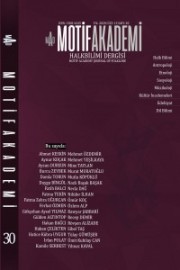FOLKLORİK TEMSİLİN SİMGESEL DÖNÜŞÜMÜ
SYMBOLIC TRANSFORMATION OF FOLKLORIC REPRESENTATION
Author(s): Kafiye Özlem AlpSubject(s): Anthropology, Semiology, Sociology of Culture, Post-War period (1950 - 1989)
Published by: Motif Halk Oyunları Eğitim ve Öğretim Vakfı
Keywords: Folklore; representation; semiotic; symbol; symbolic transformation;
Summary/Abstract: Folklore establishing considerable part of the culture is a representation field of a people from past to today by its functional and symbolic sides. Transforming socio cultural and socio-economic conditions with modernity brought fast transformation of folkloric culture as well. Linguistics works developing together with modernity took culture in general and folkloric culture particularly to the agenda to be handled as a language system approach. Although these approaches contain differences, they supply a static structure as code. Whereas, folkloric culture can be recognized as layered living organism of past, present and future. Especially representation and foundation of symbolic and functional sides of folkloric culture forms basic axis of these discussions. In folkloric culture, representation can be considered basically in two steps. The first one of them is the side of folkloric culture coming from the past, existing within itself, living today, conserving and saving. The other one is the side of folkloric representation belonging to the past but tried to be reconstructed in present. This second representation case turned upside down the folkloric representation by considering it as a semiotic system which was functionally and symbolically integrated within itself. Symbolic field of folkloric representation is isolated from its content. This abstraction points to the position of upset tool of culture industry by getting forms and symbols to the front. Therefore, approaching methods to folkloric culture studies post 1960 have been investigated by its symbolic, functional and semantic dimensions in this study. Further, how folkloric culture had been realized, worked and dragged to transformation has been discussed in theoretical dimension.
Journal: Motif Akademi Halkbilimi Dergisi
- Issue Year: 13/2020
- Issue No: 30
- Page Range: 689-700
- Page Count: 12
- Language: Turkish

